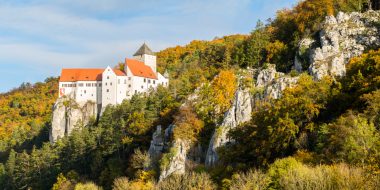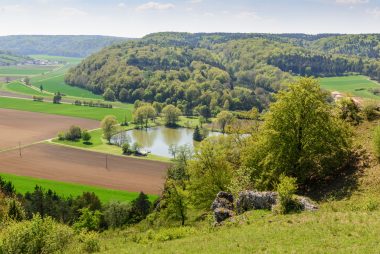The Altmühltal in the Bavarian administrative districts of Upper Bavaria, Upper Palatinate and Middle Franconia, which was founded in July 1969 and currently covers almost 3,000 km² in size, is located north of Ingolstadt. It follows the course of the almost 230-kilometre-long Altmühl River from its source on the 550-metre-high mountain range “Frankenhöhe” near Leutershausen in the district of Ansbach near the border of the two federal states of Bavaria and Baden-Württemberg to its confluence with the Danube near Kelheim in the district of the same name southwest of Regensburg.
Enchanting holiday paradise between Nuremberg and Ingolstadt
As a holiday and leisure region, the Altmühltal has been very popular for decades among nature lovers and sporty active holidaymakers if you want to spend your holiday in Bavaria , especially because of its picturesque landscape with bizarre rock formations, dense forests and clean bathing waters. Hikers use the approx. 115-kilometre-long “Limes Hiking Trail” from Gunzenhausen in the Weißenburg-Gunzenhausen district to the spa town and district of Bad Gögging in Neustadt an der Donau. Cyclists, on the other hand, like to ride on the approx. 250-kilometre-long “Altmühltal Cycle Path” from Rothenburg ob der Tauber to Kelheim, on the route of which famous natural monuments such as the Dollnstein between Eichstätt and Treuchtlingen and the rock group “Twelve Apostles” near Solnhofen are located.
Whether on land or on water: the Altmühltal is made for sports holidays

The Franconian Lake District is one of the most popular holiday areas in northern Bavaria

The via ferratas in the Altmühl Valley have long attracted active holidaymakers from all over the world
The Altmühltal is also known nationwide and internationally as a challenging and scenically extremely attractive climbing area. In the Franconian Jura, “climbers” will find over a dozen via ferratas of different levels of difficulty. The “Altmühltaler Adventure Park” below the Hirschberg castle grounds in the municipality of Beilngries has a rock cellar labyrinth including an underground brewery museum worth seeing, a team training area as well as a forest adventure trail and a forest high ropes course. In the “Pappenheim Forest Climbing Garden” in the city forest, the “Bambini Parcours” for young climbers and the long cable car attract many families. Open all year round and daily from 8:00 a.m. to 8:00 p.m. is the “Waldhochseilgarten Hammertal” at the Naturfreundehaus in Sausthal-Kelheim. Directly on the Altmühltal Panorama Trail and Altmühltal Cycle Path is the 45-metre-high climbing rock “Burgsteinfelsen” near Breitenfurt and Dollnstein, which is considered one of the most beautiful geotopes in Bavaria and often serves alpinists as a training opportunity. For over 100 years, the versatile climbing areas in the primeval Danube Valley near Wellheim have enjoyed a great reputation. Among the most famous routes are the “Dohlenfelsen” in the Konstein area, the “Weiße Wand” and the “Fensterlwand” in the Aicha area as well as the “Felsengarten”, the “Lochwand” and the “Oberländer Turm” in the Oberland area.


